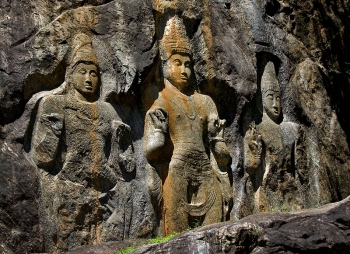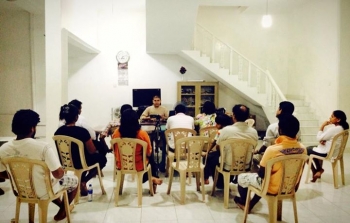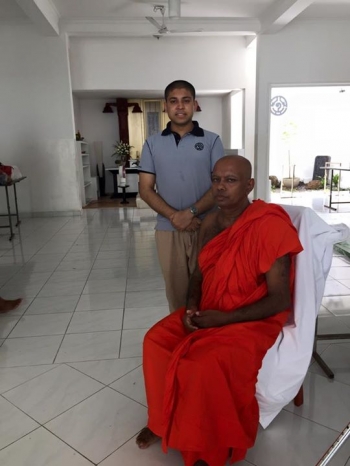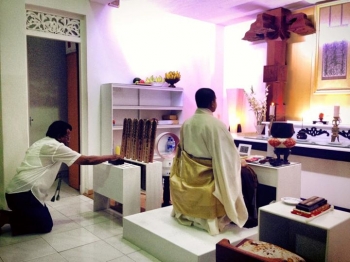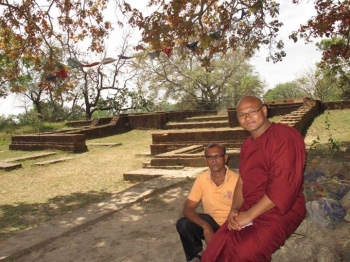A saffron-clad Buddhist monk is one of the most common sights in Sri Lanka, where the doctrine of the Buddha has been venerated for over 2,000 years. During the early 1980s, however, a different type of monk could often be seen walking the island’s streets. Foreigners, they carried a flat-faced drum in one hand and a stick in the other, which they used to beat the drum as they went along. And while they also wore saffron robes, these were different in style. Thus, the curious general public slowly became aware of a school of Buddhism that had been absent in Sri Lanka since the period of the Anuradhapura kingdom (377 BCE–1017 CE). Its existence came as something of a revelation. Eventually, people learned that the foreigners were Mahayana Buddhist monks, and that they had come to Sri Lanka from Japan.
The Anuradhapura period, when the Mahayana tradition commenced in Sri Lanka, saw some of the greatest Sri Lankan kings, along with the emergence of some of the foremost archaeological structures to be built in ancient Ceylon. The era saw the dawn of the two great schools of Buddhism in Sri Lanka: the Mahavihara and the Abhayagiriya, named after the respective monasteries where they flourished. It is well known that while the Mahavihara became the epicenter of the Theravada tradition, the Abhayagiriya Vihara eventually became the home of the Mahayana, or more accurately, an offshoot known as Vaitulyawada. In 410, the Chinese Buddhist monk Faxian (337–422), who traveled on foot to Sri Lanka, noted in his travelogue that the pro-Mahayana Abhayagiriya Vihara housed as many as over 5,000 monks (Beal 1869, 151). This clearly shows that, while the great Sri Lankan chronicle, the Mahavamsa, downplays the significance of the Mahayana tradition in Sri Lanka, it was in fact a well-accepted school of Buddhism, and one which also attracted royal patronage.
The Abhayagiriya Vihara was founded by King Vattagamini (r. 89–77 BCE) during a time in which Theravada popularity was at its height. It is generally accepted that the Mahayana was brought to Sri Lanka soon after it was made popular in the Indian subcontinent by Nagarjuna in the 2nd century. However, the arrival of the Mahayana tradition did not stand favorably with the orthodox practice of Buddhism that had existed on the island since Venerable Mahinda arrived there from India in the 3rd century BCE. By the 9th century, during the reign of King Sena I (846–66), Vajrayana had also been introduced to Sri Lanka from eastern India, perhaps through the goodwill of the Abhayagiriya Vihara monks. Although both were important for the successful establishment of Buddhism in Sri Lanka, the Mahavamsa omits the activities of the Vajrayana and Mahayana schools to a great extent, while recording almost all the important activities relating to the orthodox Theravada tradition. Nor does the Mahavamsa make mention of the existence, much less the construction, of such colossal archaeological sites as the Mahayana temple Buduruwagala in the south, which features seven giant statues of bodhisattvas.
The Mahayana and Vajrayana schools of Buddhism enjoyed only a relatively brief existence in Sri Lanka. As the royal patronage and power of the Mahavihara increased, eventually the unorthodoxy was brought to a halt. Writing in the 13th century, Jayabahu Dharmakirti states in his Nikayasamgrahaya (Collection of writings on the books of the doctrine) that the acceptance of Vajrayana by King Sena I was like a “grasshopper reaching the flame thinking it is gold unaware of its danger” (Fernando 1908, 22). It is easy to understand the condemnation of the Mahayana and Vajrayana traditions in what was otherwise a largely orthodox Theravada nation.
Venerable Swarna of Nepal has been a resident student monk in Sri Lanka for over eight years. Well versed in the Buddhist doctrine, fluent in eight languages, and with a degree in psychology, he has some interesting insights into the current practice of Buddhism on the island. “There are so many characteristics of Vajrayana and Mahayana intermixed into the Theravada practices of Sri Lanka,” he told this author. “Hewisi [the daily adoration of the Buddha using drums and horns] is specifically a Mahayana tradition. The inclusion of bodhisattva worship and their statues in temples is also a tradition that belongs to Mahayana, while we can also connect it to the worship of the 24 past Buddhas as well as the future Buddhas. We also have the practice of chanting mantras, which has a definite relationship with the Vajrayana practices of Tibet. I would like to state that, while the practice of the Theravada Vinaya [monastic discipline] is strong, the Mahayana Vinaya practice is more strenuous and applied, contrary to the belief of the Theravadins.”
